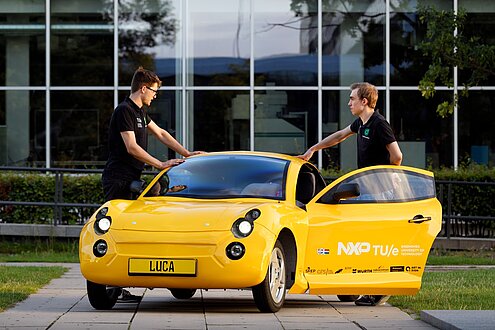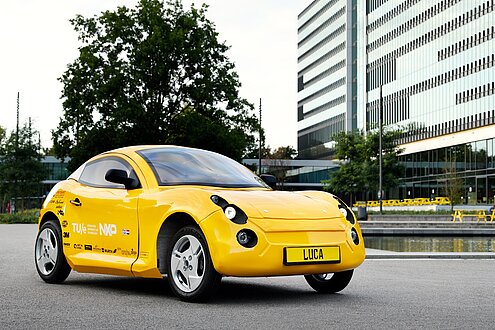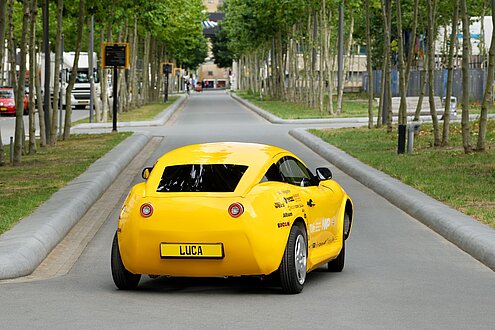TU/e-students present the ‘waste car’ Luca: a car made almost entirely out of waste

Together, we produce 2,1 billion tons of waste each year – that is enough to fill the Philips-stadium to the roof 7380 times. To show that waste can be reused in a useful way, student team TU/ecomotive from the Eindhoven University of Technology presents a car made almost entirely out of waste. The result is a sporty looking, electric car named Luca. Luca’s chassis is made out of flax and recycled plastics, of which the plastic is taken straight from the ocean. Also, the body, finish, windows and interior are made out of recycled materials like PET-bottles, ABS and even refined household waste

Light and efficient
Luca is a compact car with two electric motors in the rear wheels. The car reaches a top speed of 90 kilometers per hour and a range of 220 kilometers. Once converting this electric range to fuel economy, the car provides an approximate range of 180 kilometers per liter of petrol. Besides the efficiency provided through its electric drive train, a great deal of Luca’s efficiency comes from its lightweight construction: the car only weighs 360 kg without batteries. That is more than half of the weight of comparable cars. Besides, this the car only requires a total of 60 kg of batteries, which in comparison to the hundreds of kilograms for other electric cars, stands as another attribute to its resourceful design.

Plastic out of the ocean
The chassis of Luca consists of a unique sandwich panel that the students have developed in collaboration with several companies. The sandwich panel consists of three layers: the two outer layers which are made from a combination of flax fibers and a plastic taken from the ocean, and a middle layer, namely a PET honeycomb core. This combination ensures that these materials together have maximized their strength by pushing the materials beyond their normal end of life applications. An example of this is the core which is made 100% from recycled PET bottles. As PET can only be recycled ten times, by implementing it in a car, the lifecycle can be drastically extended. After all, the lifespan of ten cars last longer than that of ten plastic bottles.
The rest is also taken into account
The implementation of waste, however, does not end there. For example, the body of the car is made out of recycled ABS, a hard plastic used in lots of consumer products, like toys, televisions and kitchen products. The car gets its yellow color because of a wrap, a colored foil, instead of a paint job. This foil can be removed without leaving any residues. This leaves a clean plastic that requires little to no refinement in its recycling stream. The side and rear windows are also made out of recycled materials. The recycling process gives the windows a luxurious, black tint. Sustainability can be anything but boring.
The interior also features lots of waste materials. For example, Luca has two very comfortable, custom seats, of which the cushions are made out of a combination of coconut fiber and horsehair. The fabric surrounding the cushions is made out of recycled PET but looks and feels like suede. The middle tunnel showcases the use of a plastic that is derived completely unsorted household waste. Besides this, even residual waste from the manufacturing process of the car itself it used, by consolidating the offcuts from the outer layers of the sandwich plate.
Circular economy
All this creates the sporty, sustainable Luca. “The team want to show that sustainable technology can be sexy, by implementing waste as a valuable material into a sporty looking car.” says team member Lisa van Etten. This way, the team hopes to make people and industry aware of their consumption and contribute to the development towards a circular economy.








